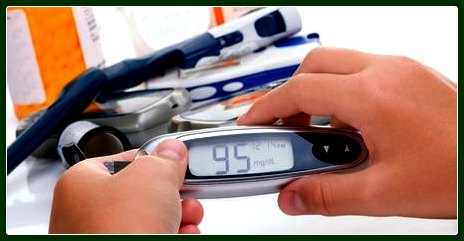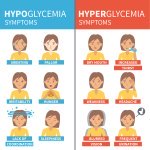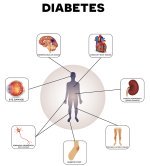Normal Range Blood Sugar Levels

We believe that the following normal range blood sugar levels are optimal for healthy individuals based on information from a variety of sources like the American Diabetes Association, National Institute for Clinical Excellence (NICE) and International Diabetes Federation and numerous books on the topic.

Please note: The international standard way of measuring blood glucose levels are measured in millimoles per liter (mmol/L). However, the United States and many other countries express glucose concentrations in terms of milligrams per deciliter (mg/dL). You can convert mg/dL to mmol/L by dividing by 18.
Maintaining normal range blood sugar levels is critical to good health and longevity. According to the International Diabetes Federation, a normal blood sugar range for people without diabetes and who are not fasting should be between 82 mg/dL (4.4 mmol/L) and 110 mg/dL (6.1 mmol/L) with 82 mg/dl being optimal.
However, your blood sugar levels can vary widely depending on what you eat as well as other health factors like exercise, fatigue, illness, adrenal health and how hydrated you are. Because what you eat is really the biggest factor that effects your blood sugar levels, normal blood sugar ranges are reported based on how long it has been since you have eaten.
There are some other reasons that your normal range blood sugar levels may vary from what is typically considered normal:
- If you have diabetes
- Your age may effect your levels
- Certain medical conditions like adrenal fatigue
- Genetic heritage
- Individual patient considerations like hypoglycemia unawareness
How do you determine what your blood sugar levels are?
Two ways to measure your normal range blood sugar levels over time:
- A1C Test
- Blood Sugar Self Test using a Glucose Meter
An A1C test will reflect your average blood sugar level for the past two or three months For the A1C test, your doctor or a lab will need to take a blood sample.
You can perform your own blood sugar test using a glucose meter purchased at a pharmacy, but it will only tell you what your blood sugar level is at the time of the test and your results can vary widely based on how long it has been since you ate last, among other things. Therefore if you want to get an accurate assessment of your blood sugar status, you will need to test your blood throughout the day for at least a couple days.
Why should you care about knowing about normal range blood sugar levels?
Blood sugar - also known as glucose - is your body’s primary source of energy. The actual amount of glucose in your blood and body fluids is very small, slightly less than two typical sugar packets or approximately one teaspoon.
If your blood sugar gets too low, also known as hypoglycemia, then there isn’t enough glucose in your blood to feed your brain and other tissues. When this happens, often due to skipped meals or after excess sugar consumption, it becomes hard for people to think and they may feel shaky. People are generally considered hypoglycemic if their blood sugar consistently falls below 70 mg/dl (4 mmol/L). In more serious situations caused by the consumption of alcohol poisons, or certain medications (like insulin), infection or prolonged starvation, can result in severely lowered blood sugar and cause seizures, unconsciousness, brain damage and death. Low blood sugar can be quite a problem for diabetics if they inject themselves with too much insulin.
On the other hand, high blood sugar, also known as hyperglycemia, happens when too much glucose is circulating in your blood. Typically you are considered hyperglycemic if your blood sugar goes above 250-300 mg/dl (15-20 mmol/L). If you have high blood sugar temporarily, you are unlikely to have any symptoms. However, if your fasting blood sugar levels consistently stay above 126 mg/dl (7mmol/L) then your blood vessels and organs can be damaged. According to Dr. Bernstein in "Dr. Bernstein’s Diabetes Solution: The Complete Guide to Achieving Normal Blood Sugars" (2011), the longer the glucose molecules are free floating in your blood, the greater the chance they will attach to cell proteins and damage them, resulting in what is known as advanced glycation end products (AGEs), which can cause your tissues and organs to degenerate. Long term this results in a whole list of nasty things that commonly plague diabetics with poorly controlled blood sugar like cardiovascular disease, impotence, kidney failure and premature death.
Why do Normal Blood Sugar Levels Fluctuate?
Normal range blood sugar levels fluctuate depending on what you eat. Food that is high in simple carbohydrates digest quickly and are rapidly absorbed into your bloodstream. For example, if you drink a glass of orange juice which contains eight teaspoons of sugar and no fiber, the sugar in the juice will rapidly be absorbed into your bloodstream.
It is important to know that the normal amount of sugar in your blood - the amount that results in normal blood glucose levels - is approximately one teaspoon. So if the eight teaspoons of sugar from the orange juice were to be absorbed into your bloodstream unmetabolized, you would rapidly go into a hyperglycemic coma and die. Fortunately, your pancreas saves the day by quickly secreting large amounts of insulin to process all that sugar.
Insulin is a hormone that binds to receptors on your cells in order to activate glucose transporters that grab the sugar molecules and bring them inside your cells. Your cells only have a limited capacity for sugar to enter and excess sugar is stored as fat. Not only is insulin a fat-building hormone, but when secreted in excess (like when you eat alot of carbohydrates) is also increases your cholesterol, increases blood pressure and causes the linings of your arteries to thicken.
Back to normal range blood sugar levels, after insulin comes to the rescue, your blood sugar levels rapidly drop. Because in this example you only drank the orange juice with no other food, your blood levels would spike quickly and then drop rapidly due to the action of insulin. This spike followed by a rapid drop in blood sugar will often cause you to feel hungry and may even make you temporarily hypoglycemic and cause you to feel shakey.
This was an extreme example but, the same sort of thing happens any time you consume carbohydrates without also eating plenty of fiber, protein and healthy fats to slow down the absorption of sugar into your bloodstream. This is also why one of the best things you can do to maintain normal blood sugar levels naturally is to eat a low carbohydrate diet.
For the majority of healthy individuals, normal range blood sugar levels are as follows:
- Fasting blood sugar levels should be between 70 and 100 mg/dL (3.9 to 5.6 mmol/L )
- Optimal non fasting glucose level in humans before a meal is less than 100 mg/dL (5.5 mmol/L )
- When operating normally the body restores blood sugar levels to a range of 4.4 to 6.1 mmol/L (82 to 110 mg/dL) within two hours after eating
- Shortly after a meal the blood glucose level may rise temporarily up to 7.8 mmol/L (140 mg/dL)



New! Facebook Comments
What do you think? Share your thoughts below...